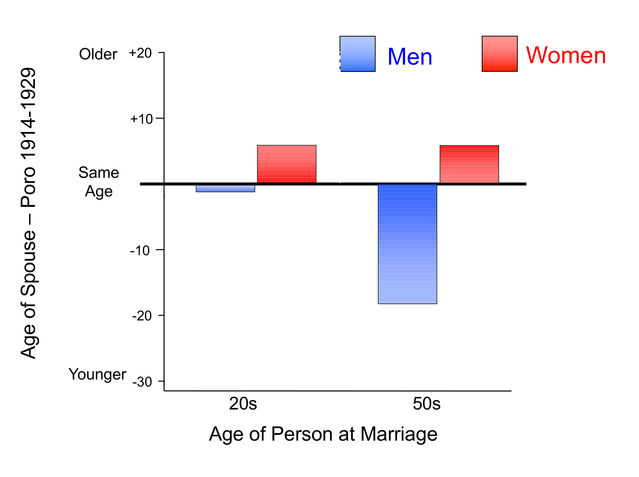Mating
Why Are Older Hollywood Actors Paired With Such Young Women?
Are Hollywood directors trying to relive their youth, or please the audience?
Posted February 13, 2018
The movie Phantom Thread has been nominated for the 2018 Academy Award for best picture. The movie focuses on the passionate relationship between a highly successful London dressmaker (played by Daniel Day Lewis) and a waitress (played by Vickie Krieps). For his performance in the movie, Daniel Day Lewis has been nominated for the 2018 Academy Award for Best Actor in a Leading Role.

Daniel Day Lewis was born in 1957, whereas the woman who plays his romantic interest, Vickie Krieps, was born in 1983. Thus, he is 26 years older than her. This kind of age spread is not unusual in Hollywood. In the classic romantic movie Casablanca, which won the Academy Award for Best Picture in 1942, Humphrey Bogart was 43 and Ingrid Bergman was 24. And in Gone with the Wind, which not only won multiple Academy Awards in 1939, but went on to become one of the highest grossing movies of all times, Clark Gable was age 37 and his romantic interest, Vivien Leigh, was 25.
People magazine’s cover once asked “Why are leading actors matched with costars half their age?” The magazine article suggested the possibility that it was because Hollywood directors tend to be older males, who are “trying to relive their youth.”
But is the phenomenon of younger women in relationships with older men something unique to the culture of Hollywood?
Consider Figure 1, which is drawn from people seeking mates on the dating site OKCupid (Rudder, 2014). One of the founders of the website, Christian Rudder, was a math major at Harvard, and he was able to get some insight into people’s mating preferences by recording the choices made by the website’s millions of users. Rudder reported that men in their twenties clicked on pictures of women in their age range (on average, about 2 years younger), and that women in that age range clicked on pictures of guys around a year older, on average. But look what happens among older people – women are still clicking on pictures of men around their age, now with a slight preference for men about 2 years younger. But men in their 50s click on women fully 25 years younger than themselves.

So, it’s not just aging Hollywood directors, it’s also aging men in general who are interested in relatively younger women.
Is it something about American culture more generally perhaps?
Probably not. In fact, across cultures, men marry women around their own age when they are young, but much younger women if they remarry later in life (Kenrick, 2010; Kenrick & Keefe, 1992). Figure 2 shows the ages at men’s and women’s spouses for the Pacific island of Poro between the years 1914 and 1929 (before people on that island had ever seen a Hollywood movie, or even seen many Europeans outside of an occasional missionary). Women on Poro married men slightly older than themselves regardless of their age. Young men on Poro married women around their own age. But older men married women who were almost two decades younger than them (Kenrick & Keefe, 1992). The same pattern was found in Brazilian marriages in 1996 (Otta et al., 1999).

These age differences in mating preferences seem to be linked to the fact that women and men seek relatively different resources in their mates. Women around the world and throughout history have placed relatively more emphasis on a man’s social status and ability to provide resources (which tend to increase as the man gets older). Men, on the other hand, tend to seek features that are associated with fertility, such as healthy appearance and relative youth (a woman’s fertility is high in her twenties, but declines as she ages). Note that in the movie Phantom Thread, Daniel Day Lewis’s character is highly successful, wealthy, and well-connected to London’s social elite. Vickie Kreps’ character, on the other hand, works as a waitress. But she is young and beautiful.
This example reminds us once again of the importance of thinking critically when one hears “expert opinion” in the media. It is always important to take a look at the evidence supporting the claims one reads about. In the case of the hypothesis about older male directors trying to relive their youth, there was no evidence offered. But a look at the research findings on actual mating preferences suggests that it is normal human preferences driving the Hollywood director’s choices, rather than the other way around.
This post coauthored by David Lundberg Kenrick

Related blogs
A link between a prostitute’s age and her income: A seemingly salacious topic answers a broad scientific question.
When statistics are seriously sexy: Sex, lies, and big data.
The Mind as a Coloring Book: Universal mechanisms reveal surprising cultural diversity.
The Mind as a Coloring Book 2: Why cultural diversity does not mean a blank slate mind.
References
Kenrick, D.T. (2011). Sex, murder, and the meaning of life: A psychologist investigates how evolution, cognition, and complexity are revolutionizing our view of human nature. New York: Basic Books.
Kenrick, D. T., & Keefe, R. C. (1992). Age preferences in mates reflect sex differences in human reproductive strategies. Behavioral and Brain Sciences, 15(1), 75-91.
Otta, E., da Silva Queiroz, R., de Sousa Campos, L., da Silva, M. W. D., & Silveira, M. T. (1999). Age differences between spouses in a Brazilian marriage sample. Evolution and Human Behavior, 20(2), 99-103.
Rudder, C. (2014). Dataclysm: Who we are (when we think no one's looking). New York: Random House.


